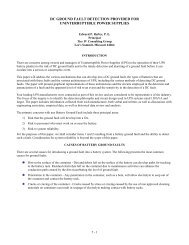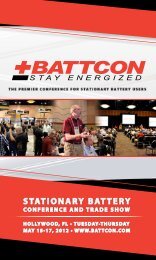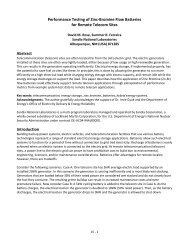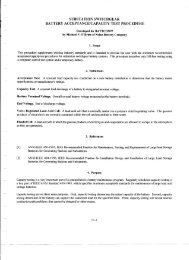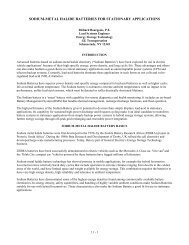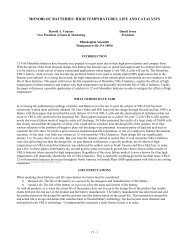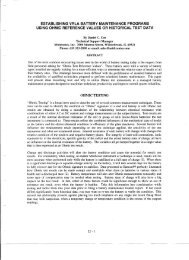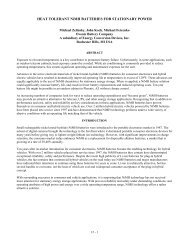FLOODED (VLA ), SEALED (VRLA), GEL, AGM TYPE, FLAT PLATE ...
FLOODED (VLA ), SEALED (VRLA), GEL, AGM TYPE, FLAT PLATE ...
FLOODED (VLA ), SEALED (VRLA), GEL, AGM TYPE, FLAT PLATE ...
Create successful ePaper yourself
Turn your PDF publications into a flip-book with our unique Google optimized e-Paper software.
It was interesting to see that the capacity was higher after the seismic test. It is due to extra charging and the extra cycle we<br />
did. Apparently, the float charge with 2,25V at 62,8°C could not keep both electrodes in a charged condition. Only at higher<br />
voltage could we completely charge them. Analysing the lead sulphate content in the positive and negative plates, we<br />
observed after 450 days at 62,8°C, 8,4% PbSO4 in the negative and less then 2% in the positive, confirming, that the negative<br />
plate was not sufficiently polarized.<br />
First, this tells us that, in normal battery operation, we should not float charge the <strong>VRLA</strong> <strong>GEL</strong> at 62,8°C. In the Operating<br />
Manual, the battery temperature is restricted to 45°C and requires a float charge voltage of 2,25V/cell from 10°C to 45°C. To<br />
keep the full charge at higher temperatures, we would have to increase the float voltage. Today, a lot of battery<br />
manufacturers require a float voltage reduction at higher temperatures. It is the wrong direction and it makes the PCL 3, the<br />
premature capacity loss, the sulphation of the negative plate more likely (Ref. 1 and 2).<br />
To achieve a long service life, <strong>VRLA</strong> batteries need a polarization of the negative plate. This can be achieved, if the materials<br />
in the cell are avoided, which reduce the hydrogen over voltage.<br />
Did the growth of the positive plates and the poles restrict the life? No. A considerable growth was observed of 3 - 14mm for<br />
OPzS, OPzV as well as OGi at the end of the test, but the pole bushing tolerated it and remained acid- and gas-tight.<br />
And how is the cycle life of the <strong>VRLA</strong> tubular <strong>GEL</strong> in comparison to <strong>VLA</strong> tubular? The test was done according to IEC 60<br />
896-2 on 6 cells 6 OPzV 420: 3h discharge with 84A and 21h charge at 2,40V during 6/1999 till 12/2004. After 1500 cycles,<br />
the capacity was still 100%.<br />
Table 4 Endurance data of <strong>VRLA</strong> tubular <strong>GEL</strong> and <strong>VLA</strong> tubular<br />
<strong>VRLA</strong> tubular <strong>GEL</strong> OPzV<br />
<strong>VLA</strong> tubular OPzS<br />
On float with 2,23V at 62,8°C 450 days 550 days<br />
IEEE 535-1986<br />
Cycles according to IEC 60 896-1, 2<br />
80% DOD<br />
22,5 years at 25°C 27,5 years at 15°C<br />
35 years at 20°C 42,7 years at 20°C<br />
> 1700 > 1700<br />
Apparently, the endurance time during float of <strong>VRLA</strong> tubular <strong>GEL</strong> is excellent, positioned between <strong>VLA</strong> tubular and <strong>VLA</strong><br />
flat plate types. Leaking, drying out, and special corrosion at negative grids, etc. are apparently overcome, so that the true<br />
lifetime restriction, dependent on the corrosion of the positive grid is present.<br />
The <strong>VRLA</strong> tubular <strong>GEL</strong> battery has a similar cycle life as the <strong>VLA</strong> tubular, which qualifies it for photovoltaic applications.<br />
6 - 7



